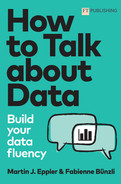Preface
Our aim with this book is to empower you to build a skill called data fluency and to lead high-quality analytics conversations with diverse groups of people in your organisation. We believe that our highly visual approach and our use of vivid, real-life dialogues and simple, varied examples will speed up your learning progress and make your journey to data fluency a more seamless – and hopefully entertaining – one. To start, ask yourself this question:
What is the most powerful tool to make sense of data?
If you’re thinking about a giant relational database, a powerful machine learning algorithm, a clever Python library or a sophisticated R script, think again.
Yes, you certainly need enormous databases to harness the power of big data. And yes, algorithms that can autonomously learn from data are a key element to derive relevant patterns out of a constant stream of data. We also agree that Python and R are two of the most widely used programming approaches to ‘torture data till it speaks to you’. But there is an even more powerful tool to make sense of data, as you will discover in this book.
The most powerful tool for making sense of data is a good conversation.
It is through conversations that business requirements are translated into analytics endeavours and data queries.
It is through conversations that query results and data reports are shared, scrutinised, put into a wider context and ultimately made applicable.
There cannot be high-quality data analytics without high-quality conversations. For data to become truly valuable, it must be part of our everyday discussions.
Yet in reality, such conversations often break down or derail. Data analysts and managers don’t speak the same language, have radically different perspectives or lack insights into each other’s methods and constraints. This at times makes reaching a common view on data difficult.
There are two keys to master this challenge and you can find both of them in this book.
First, we all need to understand the basics of data by establishing a solid comprehension of elementary statistics (and its terminology), as statistics is the language of data. In this effort, we need to make things as simple as possible (but not simpler, as Einstein noted) and be aware of potential biases in our data.
This will enable us to talk about data competently and critically.
Second, we need to be able to design good data dialogues to make analytics work in organisations. We need to know how to ask good questions about data, how to (interactively) present and visualise data, and how to tell good data stories.
This will enable us to talk about data clearly.
It has certainly been an interesting journey for ourselves to write this communication guide to data analytics. To make this book a reality, the two of us had numerous constructive conversations with a variety of colleagues whom we’d like to thank at this point.
